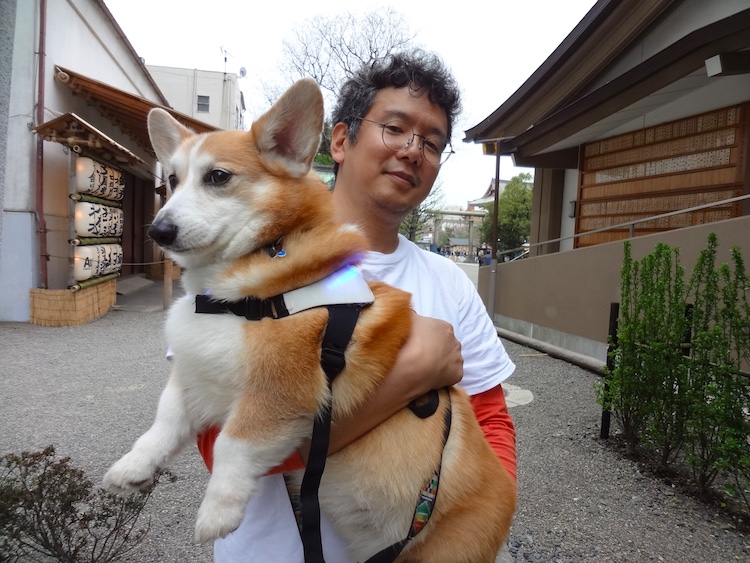Inupathy goes to the heart of the augmented dog
Published 12 April 2016 by Cherise Fong
“You know what? I’m happy.” dixit Droopy, Tex Avery’s famously sad-faced basset hound. To finally know what your dog is really feeling, Inupathy offers you a collar that measures the canine’s heart rate and displays its mood in a spectrum of colors. This Japanese prototype just may herald a new era in inter-species communication.
Tokyo, from our correspondent (words and photos)
These days, there exist a number of pet wearables to monitor, measure and communicate with your dog (or cat). Some feature GPS, camera, speaker, and various sensors, such as the Petpace and Voyce collars, which monitor heart rate and focus on the animal’s health. But they may come with a few caveats: heart rate sensors can also capture parasite external noise, the use of the accelerometer limits their accuracy to resting (or dreaming) state, and finally, the data itself can only be practically visualized on a separate device (PC, smartphone, etc).
Inupathy (“dog”+“empathy”), featuring acoustic sensors that exclusively capture the dog’s internal heart rate and LEDs that display colors and patterns according to its emotional state, is focused above all on Fido’s mental health. And according to Joji Yamaguchi, the creator of Inupathy, a dog’s happiness depends directly on the quality of its relationship with its human partner.
Inupathy displays the dog’s emotional state (demo):
Simplistic, you say? “Many people tell me they know everything about their dog,” says Joji. “But when I ask these same people if they know everything about their child, they say no. What is the difference between a child and a dog? The dog is a whole other entity, it’s impossible to know everything about him. It’s important to admit that there are things we don’t know about our dog and to make the effort to understand him. His expression is important, but there are things we can’t see… Many people think that dogs wag their tail when they’re happy, but that’s not always the case. Dogs can also wag their tail when they want to please their owner.”
A few years ago, Joji, a software engineer with a background in biology, began developing a special collar in an attempt to better understand his corgi Akane by analyzing heart rate variability (HRV). He identified specific patterns corresponding to happiness and concentration, which respectively trigger rainbow and flashing LED displays on the collar. The rest of the time, Inupathy displays a hue corresponding to the number of heartbeats per minute, varying from deep blue (most calm) to bright red (most excited). The hyper-reactive result resembles a canine lie-detector with a rainbow spectrum.
Akane concentrates on finding his treats, as Inupathy flashes in sync with his heartbeats:
The first discovery Joji made while Akane was wearing the collar was that his voice was not enough to calm his dog after an earthquake, for example. But once Joji touched him, he immediately saw the difference on the collar, which displayed a calm blue, even though Akane seemed to have the same expression. Joji was also able to visualize the difference in heart rate when Akane barked at a cat (red, aggressive) or at other dogs (green, wanting to play), even though it sounds like the same bark.
“It’s like with a child. When your child tries to tell you something but you don’t understand, he gets discouraged. But if you show that you understand, he tries to tell you more.”
Joji Yamaguchi, inventor of Inupathy
“Since he has been wearing the collar, Akane has become more expressive, more bold,” Joji explains. “He knows that I’m learning things about him, that I pay more attention to him when he wears the collar. It’s a sign that it’s time to play.” In short, the inupathically augmented dog is designed to improve canine-human relationships in the long-term.

While research has been done to develop a professional “cyber-enhanced” harness for working dogs, we can also imagine how a more refined version of Inupathy could be useful when paired with service or search and rescue dogs, as well as serving as a visual tool to ease communication between trainers and owners. And once Inupathy’s HRV data is in the Cloud, many other smart pet-home applications are possible: toys that activate according to the dog’s level of excitement, a food dispenser that releases a treat when the dog is concentrated, a toilet that analyzes urine or feces… Joji already has in mind a complete IoT network centered around the dog.
As Inupathy’s Indiegogo campaign comes to a close (reaching about a third of its flexible goal), Joji continues to search for other sources of funding in order to create a steel mold, which would enable mass production of flexible, waterproof collars. In the meantime, Joji promises his backers (who pre-ordered some 40 collars) to deliver 3D printed, custom-size Inupathys beginning in December 2016.
Because assembly is still too complicated, Joji is not planning to make the collar available as a 3D printable kit just yet. But he is looking forward to discovering the many new inventions that will be possible once he releases the Inupathy software development kit in the near future: “Then people can add new features… It’s exciting to be part of the maker movement.”
